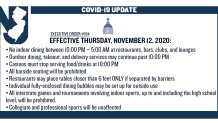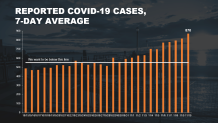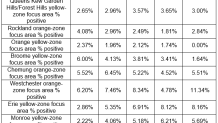What to Know
- New restrictions take effect in New Jersey Thursday; they impose a 10 p.m. indoor dining curfew for bars and restaurants and suspend interstate youth tournaments and games through high school level
- Similar hours limitations will take effect in New York Friday; Gov. Andrew Cuomo also imposed a 10-person cap on gatherings within private homes, citing that as one of three key sources of spread
- In New York City, the daily case and positivity rate increases have been jarring; as of Thursday, the rolling positivity rate was 2.6% -- and Mayor de Blasio reiterated he will close schools if it hits 3%
New COVID restrictions have gone into effect in New Jersey, some of them mirroring limits that Gov. Andrew Cuomo announced will be imposed in New York a day later, as the Garden State's governor seeks to beat back what he has described as a "devastating" recent increase in viral numbers.
Gov. Phil Murphy has acknowledged the new restrictions, which target late-night indoor dining and indoor youth sports, might be painful for some.
The weariness of the latest surge appeared to weigh on him as he issued an uncharacteristically blunt response to more questions about the impact Thursday: "You know what's really uncomfortable and annoying? When you die."
"This is not forever," Murphy said immediately afterward -- and he reminded the concerned people and businesses of his state that a large-scale shutdown like he imposed in the spring would be far more painful. He said closing schools is not part of the plan right now -- but he didn't rule it out in the future if warranted.
The state has confirmed 51 "outbreaks" associated with in-school K-12 transmission since Aug. 1, Murphy said Thursday. But the total cases stemming from those situations remain relatively low, below even 200. The governor says New Jersey's precautions appear to be working in schools. Now he needs to cast a wider web of restrictions on places where they have not stayed effective.
Effective as a of 5 a.m. Thursday, bar seating is banned completely (congregating upright within bars is already probibited), while bars and restaurants must halt indoor service from 10 p.m. to 5 a.m. That includes casinos, though gaming can continue 24/7. Restaurants can place tables closer together than 6 feet, but only if they're separated by barriers. Outdoor dining and takeout aren't affected.
"We are in the midst of a war, let there be no doubt," Murphy said Thursday. "We have to get back to the mindset that saw us crush the curve throughout the spring. We cannot be successful unless every New Jerseyan recognizes their responsibility in this fight -- especially when it comes to masks."
Murphy has said, in no uncertain terms, that there is no evidence indoor dining specifically is contributing to New Jersey's recent spike in cases. He has said there is evidence the late-night scene is fueling spread, like bartenders disproportionately testing positive and restaurants essentially morphing into clubs as the night wears, hence the "surgical" approach he applied to restrictions.
The governor didn't establish new limitations on indoor dining outside the curfew hours; he also has left the current 25 percent capacity caps in place. Most of the spread has been linked to social gatherings, from weddings to parties to small groups in private homes, as well as indoor sports at the K-12 level.

Also prohibited in New Jersey as of Thursday: interstate indoor youth sports tournaments and games, including cheerleading and competitive dance. Murphy has cited increased COVID risk from those settings, especially as it relates to indoor hockey. The ban applies through high school. The governors of Connecticut, Vermont, Maine, Rhode Island, New Hampshire and Massachusetts also agreed to suspend interstate youth hockey competitions through at least the end of the year, Murphy announced Thursday.
"Our positivity rates are up dramatically. We keep losing people. I'd say there's no one red line, but we're getting into a neighborhood that is extremely concerning," Murphy said when asked about a potential threshold for further restrictions.
"Could we take more steps? Absolutely," Murphy said on MSNBC.
In New Jersey's largest city of Newark, which has seen its positivity rate soar beyond double the increasing statewide number, Mayor Ras Baraka has already taken steps beyond what Murphy has done statewide as it relates to mandatory curfew, sports, senior housing, religious services and non-essential businesses.
“The data is reminiscent of April and May, and we cannot afford to go back there,” Baraka said. “As a matter of fact, it’s better to say we are back where we were in April and May. It’s difficult for everybody, and it’s going to take all of us to make sacrifices for this thing to go away.”
Facing some criticism for the tough measures, Baraka said bluntly: "If I don't reelected tomorrow because of what we do in Newark, then I don't care."
Murphy said Thursday he would sign an executive order giving municipalities and counties the option to regulate operating hours of nonessential businesses after 8 p.m., as Newark has done, but any local actions must comply with state rules.
Until an effective vaccine is widely available, Murphy urges New Jerseyeans to hang on and double down on COVID precautions. The numbers simply demand it.
New Jersey reported its third straight day of more than 3,000 new cases Thursday, marking the first time it reported back-to-back-to-back tallies so high since April. The 3,877 new cases reported Tuesday weren't that far off from the single-day high of 4,391 the state reported at its pandemic peak. Wednesday's report dipped to just above 3,000, while Thursday's bounced back up to 3,517.
"If we are lax, if we continue on this trajectory, our state will return to the situation we were in last spring," New Jersey's health commissioner, Judy Persichilli, warned Thursday. "This is a wake-up call. We need your help."
Hospitalizations have reached levels the state hasn't seen since early June. For perspective, roughly one out of every 500 New Jersey residents has been diagnosed with the virus over the last seven days or so, data shows.
By comparison, about one in every 800 New Yorkers has tested positive in the last week. And the numbers in the former epicenter of the national crisis are worsening along with the numbers across virtually the entire country.
Tracking Coronavirus in Tri-State
New Restrictions on Tap for New York; NYC Schools on Verge of Shutdown
New York has averaged more than 4,800 new cases the latest two days, which is half the number it was seeing at the peak of the crisis but roughly four times the daily totals it was seeing at the start of September. The daily positivity rate held around 2.9 percent. The seven-day rolling positivity rate, which provides a more accurate picture over time, is at its highest level (2.6 percent) since May 29.
Gov. Andrew Cuomo acted Wednesday, announcing new restrictions to fight back three key sources of spread that he says have been identified through contact tracing. He targeted the late-night bar and restaurant scene first, imposing the same 10 p.m. curfew on establishments licensed by the State Liquor Authority that Murphy imposed on restaurants and bars in New Jersey. Gyms must also close at 10 p.m. Those new rules take effect at 10 p.m. Friday in New York, with takeout and delivery still available.
Small social gatherings at private homes — what Cuomo called "living room spread" — are the third "great spreader" identified by contract tracing, the governor said. Starting Friday, those will be capped at 10, similar to the restriction Gov. Ned Lamont recently put in place in Connecticut. Asked if he'd consider the same for New Jersey Thursday, Murphy said "everything was on the table."
Local governments will be tasked with enforcement, which is in and of itself an ongoing point of contention between New York state and local municipalities. The NYPD will aid in enforcement in the city, Cuomo said, adding that after 10 p.m., “If the lights are on and people are drinking, they get a summons."
There is no specified end date to the new restrictions, and Cuomo warned the rules could be further tightened if the new limitations don't prove effective.
"If these measures aren't sufficient to slow the spread, we will turn the valve more and part of that would be reducing the number of people in indoor dining," Cuomo said, referring to the current 50 percent statewide capacity cap excluding NYC, where it's 25 percent. "If that doesn't work, if numbers keep going crazy, there are some scientists who believe we should close down. I hope that doesn't happen."
Mayor Bill de Blasio espoused support for the new rules in his Thursday briefing. He, perhaps more urgently than any other local official, has been expressing deepening concern for weeks about the hastening approach of a second wave.
"The city will work to enforce these rules and all the existing rules effectively. Enforcement is a crucial part of the equation," de Blasio said. "The most important part of the equation is everyone being bought in and following through on these rules. That's why we had all those months where we were doing so well."
The latest numbers have been jarring, to say the least. The city's daily case average has soared since the start of November. Last week, it hit 600 for the first time since early June. By Wednesday, it was 817. On Thursday, it hit 870. That daily case average has climbed every single day since Oct. 30, city data shows. A less measurable sign that the situation has worsened: Testing centers are now seeing long lines even into the evening hours as cases grow.

New York City schools are teetering perilously on the edge of closure, with the mayor reporting a 2.60 percent seven-day rolling positivity rate as of Thursday. That marks a nearly 20 percent increase over the last three days. De Blasio has said all public schools will have to switch all-remote for a time if it hits 3 percent.
Asked directly Thursday if he intended to make good on that pledge, the mayor said, "We're preparing for that possibility. It's a rule we put out there very clearly -- and if any day we see in the morning the indicators come out and they reach that level, then we will move immediately. The next day schools will shut down."
De Blasio said he had spoken with Cuomo's office on the matter, given the state's ability to assume authority over any closures, and he said he believes the governor will accept his longstanding 3 percent-threshold as a shutdown mark. United Federation of Teachers President Michael Mulgrew said that he always knew opening classrooms could be temporary, and stressed that the union was "prepared" for a potential re-closure.

If the citywide positivity rate hits that measure, de Blasio said the city's focus will turn immediately turn to developing a roadmap for reopening schools to in-person learning again. Still, de Blasio emphasized more than once Thursday that New Yorkers can prevent more shutdowns if they act urgently now.
"These next days are going to be crucial. I don't want there to be an air of inevitability that takes away people's agency," the mayor said. "You can stop the disease from being transmitted by doing the right thing or you can inadvertently transmit the disease by doing the wrong thing."
Parts of Staten Island have been particularly problematic as far as rising positivity rates, the mayor has said, while noting areas of Brooklyn and Queens that were troubling have seen significant progress since Cuomo established tight restrictions in narrow geographic areas within those boroughs as part of his micro-cluster approach. The tightest restrictions have since been lifted there, but Staten Island is just beginning to see what life in a focus zone is like — with four-person limits at restaurant tables, strict capacity limits for houses of worship and outdoor gatherings, and mandatory weekly testing at schools.
Cuomo had said he was monitoring the data in Staten Island and would take micro-cluster action if needed. He did that Wednesday, establishing a yellow precautionary zone in areas of the borough where positivity rates have topped 2.5 percent for seven days and hospitalizations have increased. Yellow zones apply the loosest restrictions within Cuomo's micro-cluster plan.
The governor also transitioned the new yellow zone in Westchester County's Port Chester to an orange zone, which sends schools all-remote for a period of time. He cited positivity rates that have topped 3 percent for 10 days as warranting enhanced restrictions in certain areas of that community.
Cuomo has repeatedly said his micro-cluster approach is an effective containment tool and will be the norm for New York through fall and winter, as he expects the numbers to continue to rise with no vaccine yet available. The data indicates his plan has worked: none of the initial red zones, which require total shutdowns, remain in the state. Some parts of Rockland and Orange counties have cut their positivity rates to a third of what they were without restrictions.
Within the remaining focus zones, the seven-day rolling positivity average is 4.71 percent -- a number that appears to be driven mostly by rising numbers in Port Chester and Tioga County. Cuomo moved the former to an orange zone Wednesday, given the data, and established a yellow zone within the latter at the same time.


The numbers are nowhere near what they were in April, at the peak of the crisis, officials emphasize. At that point, New York was reporting 10,000 cases a day, had 18,000 people in the hospital and was losing roughly 800 people a day. Hospitalizations are two and a half times what they were to start October, hitting a mid-June high of 1,677 on Thursday, but are manageable for now.
While treatment is generally much more effective than it was in April, and ventilator use remains much lower for hospitalized patients, it should be expected hospitalizations will continue to rise among vulnerable populations over the next few weeks. Those lag increases in cases. And deaths lag upticks in admissions.
Hospitals across the tri-state (and U.S.) have been stocking up on PPE supplies for months since the virus' first wave started to subside, and now are bracing for potentially having to access those stashes. Hospitalizations in the Hackensack Meridien Health Care system have increased six-fold in just two months.
Daily Percentage of Positive Tests by New York Region
Gov. Andrew Cuomo breaks the state into 10 regions for testing purposes and tracks positivity rates to identify potential hotspots. Here's the latest tracking data by region and for the five boroughs. For the latest county-level results statewide, click here
Source: ny.gov
A top coronavirus adviser for President-elect Joe Biden says a national lockdown of four to six weeks could control the pandemic and revive the economy as the world awaits a vaccine. Without one, the virus could continue to spiral.
At the current rate of spread, the U.S. is on pace to hit 20 million cases before Christmas, NBC News data finds. That's nearly double its highest-in-the-globe total now. No state has been untouched by the latest U.S. surge.
The country hit more than 100,000 daily cases Thursday for the eighth day in a row. It also set a new record high in daily cases, with nearly 160,000 confirmed infections, topping the previous record of 148,000 on Wednesday. California also joined Texas as the only two states to have exceeded one million total cases.



